Have you seen the Japanese War Memorial?
If you'd been in Hong Kong at the end of the Second World War, you couldn't have missed it. Here's a photo Hong Kong island's skyline in 1946, with the memorial in the centre of the skyline:
In the description of this Hedda Morrison photograph [1], it is called the Japanese Invasion Memorial: “The view is from the coastal hills about two kilometres east of Kai Tak, near the village of Ngau Tau Kok. It portrays Kowloon Bay’s extent and Hong Kong Island’s peaks. Two tall man-made features stand out: the Japanese invasion memorial (centre skyline), and [...]”. But most english references describe it as the Japanese War Memorial.
Those same references often place the memorial on Mount Cameron, or even on the Peak. Looking at the picture above, you can see it is somewhere between the two, on its own small hill. To the left (East) of the memorial the land falls to Wanchai Gap then rises to Mount Cameron. On the right (West) it falls to Magazine Gap, then rises to Mount Gough.
The Japanese knew the memorial as the 'Pagoda of the Loyal Spirits' [2], and for them it possibly served two quite different purposes. As you'd expect of a memorial it honoured those who'd died in the Battle for Hong Kong. But perhaps it also looked forward to the future battle they expected when the British returned. In a statement during the post-war War Trial, Major Hirao Yoshio described how from 1943 the Japanese government in Hong Kong knew it was unlikely they'd hold Hong Kong for a long time. (1943 was when the Japanese began losing islands in the Pacific to American forces). He went on to describe the memorial as a tomb where all the Japanese would gather to die when Hong Kong fell. [2]
In the end the surrender of Japan meant there was no fighting to retake Hong Kong island, and thankfully no need to discover whether the major's claim was true.
For those in Hong Kong after the Japanese surrender, the memorial was an uncomfortable reminder of their recent suffering. But while most agreed that the memorial needed to be removed ASAP, it turned out to be much more difficult than expected. At the surrender, the tower was less than half it's planned height. Still it was estimated to weigh several hundred tons, and was an almost solid block of reinforced concrete, rather than four walls around a hollow central space. The British engineers responsible for reviewing the structure and its plans described it as 'needlessly complex'. That complexity meant it was to take just over 18 months from the surrender to the final demolition of the tower. [2]
This newspaper clipping shows the tower's final moments, as it was demolished on 26th Feb, 1947:
By this time, contractors had already removed a lot of the concrete from the structure to make it lighter, and had chopped away all but two of the supporting legs. After this main explosion, further smaller explosions were used to break up the tower into smaller pieces, allowing them to be moved away.
Two more suprising facts about the memorial: First, a Japanese sword, supposedly 500 years old, was placed in a box and buried in the foundations. [2] Second, it may well still be there!
With demolition of the tower, the most visible evidence of the war memorial was gone, and people's attention moved on. That left the massive platform behind. It's still here today, basically unchanged.
Here's another view of the tower and platform [3]:
And here's a similar view as it looks today [4]:
The yellow building in the centre of the photo is Cameron Mansions, standing on that same platform that supported the Japanese War Memorial. To see how little has changed, look between the 'C' and 'T” of 'PICTURE' on the Time photo and you'll see three buttresses. Then between the T and U you can see a line where the wall is recessed. That same recess is visible below the two pine trees in the modern photo, and the top of the buttresses are just visible above the tree line.
Here are a couple of close-up photos, showing the recess and buttresses more clearly.
Cameron Mansions were first occupied in June 1951, so the first residents must have known what their house was built on. I wonder if they felt any reservations about it, or maybe even pride to be putting the site to good use. And I wonder how many of today's residents know the history of the platform their house rests on?
As always, if you have any memories or information to share, please leave a comment below.
Regards, David
References:
[1] One of Hedda Morrison's photographs from her 1946 collection of photos taken in Hong Kong.
[2] Newspaper clippings via the HK Public Library online collection (click a thumbnail for a larger view):
[3] Time-Life pictures have three photos of the memorial before and during demolition
[4] The present-day photo was taken from the driveway to numbers 21 and 23, Severn Road on Mount Gough. The older photo looks as though it was taken from further round the hillside and lower down - maybe from the footpath that leads from Severn Rd down to the gas station on Peak Rd? Unfortunately the trees that have grown up along that path hide the memorial site from view.


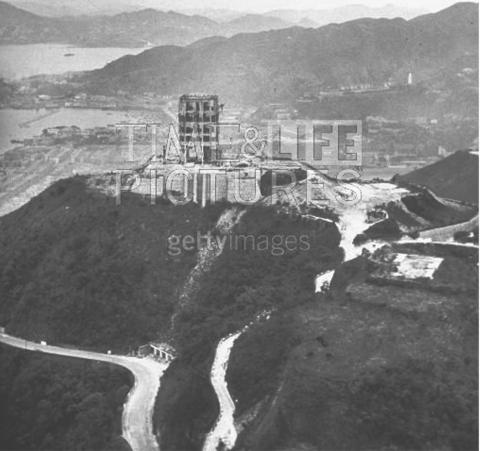
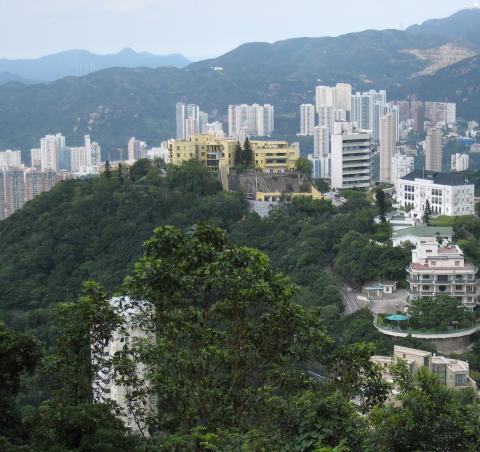
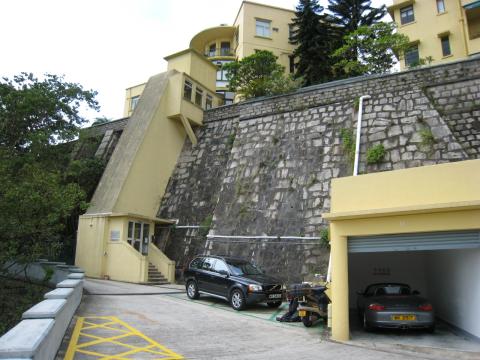
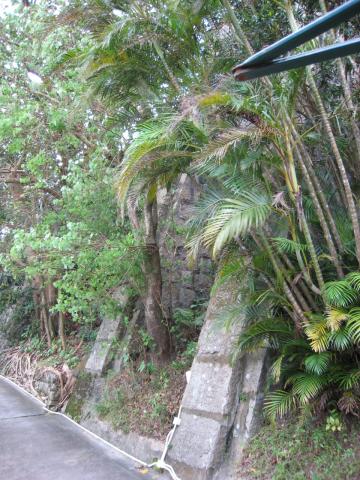
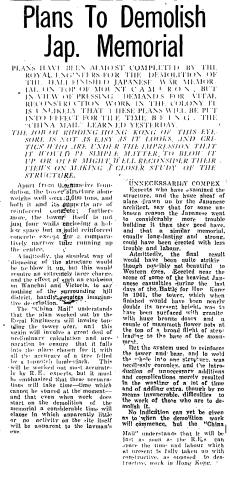
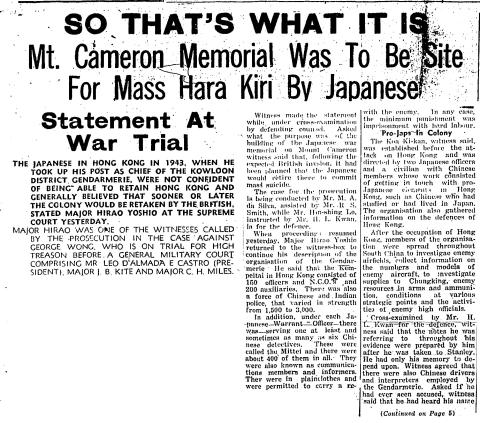
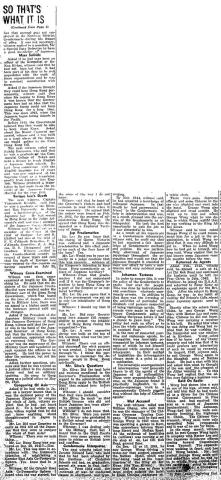
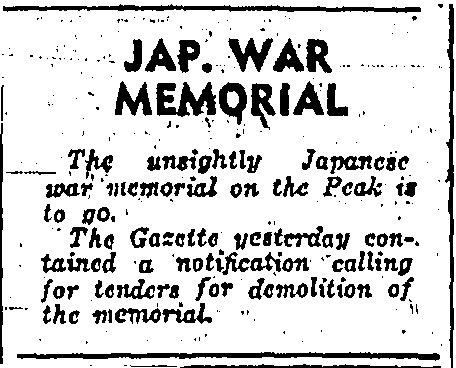
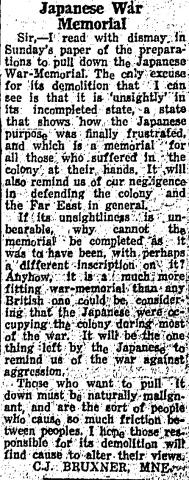
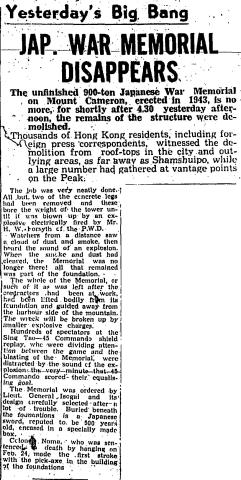
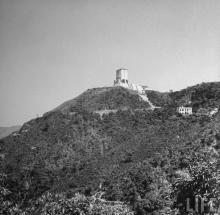
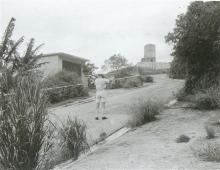
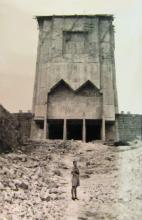
Comments
re: Japanese War Memorial
Thanks to the reader who sent in these additional photos showing the area in 1945:
I also found a picture of what the finished memorial was supposed to look like on this website. Scroll down the page - the photo is near the bottom. (Link via Hong Kong Hiking Web and hkitalk).
SCMP article on Cameron Mansions and its reputed bad vibes
Here is an article from the SCMP on Cameron Mansions. I stayed there years ago and didn't find anything spooky about it, though I was told about how it's discounted in the property market (though still costs an arm and a leg!). Was always curious about those huge walls on its foundation, little did I know I staying on the foundation to a Japanese shrine to the war dead.
__________________________________________________________________________________________
My search for the secret samurai
THERE is buried treasure in a block built over the remains of a Japanese shrine
Aug 30, 1993 | The South China Morning Post
THE tale is one of war, ghosts and buried treasure, and with Liberation Day here again, antiques collector Mike Smith thinks this time he may do something about it.
''I have this fantasy of bringing in a gang of workers at the dead of night and simply digging for it,'' said the amiable Smith with a laugh. ''Trouble is, when we brought it up I've no doubt my landlord, the ground floor tenant, and the Japanese and Hong Kong governments would all be waiting.
''I wouldn't even get a look in.'' Cameron Mansions sits right on the summit of Mount Cameron, one of those sub-Peaks which nonetheless commands a panoramic view of the harbour.
It is one of those old-style Hong Kong apartment blocks, a bulky place with wide corridors and high rooms, big windows and long balconies.
Smith has lived there since 1965, having been attracted to the place originally, he says, because the rent was so low. And even today, if an apartment becomes available, it is hard to let.
The reason is that Cameron Mansions is haunted.
''He's not a bad ghost. He's a happy, randy ghost having a good time. He knocks on ladies' bedroom doors and he touches their bottoms whenever he can,'' said Smith. ''There are no bad vibrations here.'' Cameron Mansions is just off Magazine Gap Road, and to get to the entrance you take an exterior lift from the road. The lift goes up and sideways , like the Peak Tram, for the building is perched on a huge granite-clad platform which caps the top of the mountain.
Here lies the secret of the buried treasure.
The Hong Kong News was a daily English-language newspaper put out by the victorious Japanese forces soon after they had taken Hong Kong in December 1941.
In the edition of Thursday, October 8, 1942, is a brief news item which announces that a large monument ''dedicated to the war heroes who sacrificed their lives in the operations against Hong Kong'' is to be erected on Mount Cameron.
It is clear, however, that this is no simple memorial, for the story goes on to mention the founding of the Hong Kong Shrine, ''which will serve as the centre of the spiritual life of Nipponese here''.
WHAT the Japanese were planning in fact was a spirit house, a Shinto tradition which is believed to date back 2,000 years, where the souls of samurai who fell in battle would find eternal rest and honour.
The largest of these is the Yasukuni Shrine in Tokyo, erected in 1869 by the Emperor Meiji, and venerated by the faithful as a place of repose for 21/2 million souls: Japanese soldiers on suicide missions would often bid farewell to their friends by saying, ''I'll meet you in Yasukuni.'' The Hong Kong Shrine, which would dominate the harbour as a massive symbol of Japan's sacrifice and victory, was therefore going to be of profound importance, and Lieutenant-General Isogai, the Japanese Governor-General of Hong Kong, spared no expense inits creation.
A special committee was sent to Japan to obtain a suitable architectural design. The one chosen was for a 40-metre tower approach by a long flight of steps and with a central door guarded by the statue of a lion. Inside the tower would be a chamber with urns containing consecrated bones.
On December 8, 1942, the first anniversary of Japan's attack on Hong Kong, the foundation stone was laid with great ceremony by Lieut-Gen Isogai - Colonel Noma, chief of the Kempeitai, having the honour of first swing with the pickaxe.
The site, which had previously been occupied by Cable and Wireless buildings, was cleared and work then began, under the management of a Japanese contractor using forced Chinese labour.
Granite for the base and for cladding the tower was quarried in the Happy Valley area, where it was laid out in the grounds of the Craigengower and Police Cricket Clubs for facing.
All of these blocks had to be manhandled up Mount Cameron, a steep incline covered in parts with thick undergrowth.
On the evening of December 8, 1943, the second anniversary of the invasion, another ceremony took place. At sundown, white-robed Shinto priests bearing flaring torches conducted the sacred rites designed to protect the spirits of the dead from the forcesof evil who might otherwise prey upon them.
Among those present was the Japanese sword master Kurihara, who had brought with him a samurai sword, reputed to be 500 years old, which was placed inside a special box and buried 14 metres under the top step of the shrine.
There, if the tale is true, it remains to this day.
Smith, who is one of nature's burrowers, and also a collector of antiques, is convinced that the sword is still down there, somewhere underneath Cameron Mansions.
He has been digging around in the Archives Office and compiled an impressive file on the shrine, but nowhere does it mention that the sword was ever removed.
''The point is, that this sword, if it is 500 years old, dates back to the reign of one of the greatest of all samurai, Miyamoto Musashi.
''Apart from being a great warrior, he also wrote The Book of Five Rings, which is ostensibly about the art of swordsmanship but which really sets out the principles of psychological warfare.
''In fact, it is equally as applicable to modern business techniques, and a paperback version became very popular a few years ago.
''There is even a possibility that this is his sword. And that would make it very important, and valuable, indeed.'' Smith, as an avid follower of auctions, is fully aware that a samurai sword of this period could fetch between US$1 million (HK$7.7 million) and US$2 million if it ever went on the open market.
Collecting Japanese swords is now a small but growing sector of the international arts and antiques markets. Sotheby's, Christie's and other prominent auction houses handle them regularly.
But nowhere is the market so well developed as in Japan, where the swords are heavily laden with spiritual, artistic, historic, social and political significance.
As the samurai were the ruling class in Japanese society, and only they were allowed to carry a sword, this was the most important object they could own.
The Hong Kong shrine was never completed.
One story is that there wasn't enough rice available to feed the Chinese labourers who were building the shrine, but whatever the reason, work slowed down. In July 1945, with the surrender of Hong Kong imminent, the Japanese command issued orders to stopwork, leaving a 20-metre tower of reinforced concrete and brickwork standing forlornly on the hill.
Early in 1946, the British authorities began to deal with the problem of the ''disposal of this abomination'' as it was tersely described in one internal memorandum.
The Archives Office came up trumps for the intrigued Mike Smith, and produced copies of the correspondence between the various government departments. It was therefore possible to track the entire progress of the shrine's destruction.
The structure had comprised 12 heavily reinforced legs resting on an earthwork, granite-clad platform.
An explosion big enough to bring the tower down would have caused damaged to many other buildings in the area, so the engineers had removed eight of the legs and much of the cladding.
Not only would the toppling of the remaining structure by dynamite be immensely satisfying to those who had suffered through the Japanese occupation, it would also ensure that the frame of the tower smashed into small enough pieces to be carted away.
Crowds gathered along Magazine Gap Road, and took up vantage points in nearby looted houses and unkempt tennis courts as the Public Works Department supervised the laying of the charges.
At 4.30 pm on a hot, hazy afternoon, a gong began to pound its warning: then there was a puff of white smoke and an explosion, and the monument, with its legs taken from under it, fell on its side.
''When the smoke cleared, the ruin of Japan's mute symbol of attempted domination was revealed to the cheering crowd,'' reported the South China Morning Post. What was left intact, however, was the base. Cable and Wireless sold this to Mr W K Kwan, father of the actress Nancy, and a well-known property developer.
He built Cameron Mansions on top of the base, installed the exterior lift to transport residents and visitors up to the front door, sold the building to a lady who now lives in Kuala Lumpur, and that was the end of the matter.
Why didn't anybody go looking for the sword at the time? ''I think that everyone was sick of the war,'' said Smith. ''And Japanese swords and other relics were 10 a penny. No one cared.'' Finding the sword has now become something of an obsession with Smith, who thinks he knows where the front step would have been, and wonders if sophisticated sonar devices could pinpoint its exact location in the earthwork base.
He led the way to the parking space under the apartment building.
''That's odd,'' he said. Somebody had drawn a big chalk circle on the very spot below which he estimated the sword to be. ''Must've been kids. I don't think the ghost would do a thing like that.'' The trees were still sighing from the previous day's typhoon. ''Gets spooky here sometimes,'' he muttered.
Cameron Mansions
Thanks for the extra info.
I wonder if Mike Smith still lives in Hong Kong, and if he has found out any more information about it since 1993?
war memorial
In 1945/6 my late father was in tthe Royal Navy and member of Mobile Explosive Investigation Unit #3 , Australian officer and five other ranks, attached to the US Navy. They were in Hong Kong disposing of Japanese munitions which were stored on an island in the harbour.
While there they met an ex prisoner of war who had worked on this tower, or said so anyway, and he told them there was a ceremonial sword burried in foundations. father and co trotted up to the tower at night and armed with lamps and pick axes attempted to recover said object. A few swings of the picks convinced them this was not going to be possible. 'Never seen anything so hard in my life' was the quote. Theye packed up and went for a beer. This story has lived with me for the fifty years since he told it to me as a young boy.
This story has brought it all flooded back to me. Lovely... The unit carried on getting rid of the torpedoes and mines with hardly a thought of taking torpedo filling up the hill and blowing the thing out of the ground. I think the noise would have attracted attention..... No sword but a nice letter of thanks from the Admiralty which I still have.
re: war memorial
John, thanks for writing in. It is stories like this that bring the dry history to life.
Regards, MrB
re: war memorial
Thank you for bringing it back to me
John S
Cameron Mansions
I was the writer of the SCMP article: gave me quite a start to see it again after all this time, as I had long since lost the clipping. I don't think Mike Smith ever went digging for the sword, although it had been something of an obsession for him. He was trying to raise funds to organise a proper dig, and we mailed copies of the article to a couple of Japanese associations that Mike thought might be interested. I never heard anything further, and Mike, who was retiring about that time, moved to Bangkok not long after.
re: Cameron Mansions
Thanks Ken, it's good to hear the end of the story.
Excellent Work
Great work! I became intrigued with the Japanese War Memorial after seeing an old Hong Kong photo in a book I picked up at the City Hall public library. However, I continued to look for its remains on Mount Cameron, as the old book listed the Memorial's location there. Every time I ran on Black's Link, Middle Gap Road, or Mount Cameron Road, I would look toward Mount Cameron's summit wondering if vegetation had grown over any remnants or if allied troops had effectively destroyed any evidence of this "horrible" reminder. Little did I know its location was nearer the Hong Kong Police Museum and the intersection of Magazine Gap and Peak Road. As we approach another anniversary of the Memorial's demolition on February 26, I wonder if anyone out there would be interested on visiting the site.
Anyway, thanks for your research. It answered many of my questions.
Semper Fi!
J. Sandoval - Gunnery Sergeant of Marines
Japanese 'War Memorial'
I still clearly remember the day that it was finally dynamited. It was a few days after my 7th birthday and I was sick at home with the mumps. My Mother, Father and I lived (post-WWII) at #12 Ventris Road, Happy Valley and all the occupants of Ventris Road were out on their balconies (which faced West) and cheered when the structure went up in a cloud of concrete dust. I remember it well. It was at that time I heard about the Japanese sword that was supposed to be encapsulated in the foundations of the structure and I have never forgotten it, very often dreaming (as kids are wont to do) of going there and liberating the sword for myself.
Prior to WWII we occupied #1 Ventris Road. My late Mother and I were evacuated to Australia in July/August 1940 via Manilla and arrived in Sydney on the SS Johan de Witt. We first lived at Wallaringa Mansions, Lower Wycombe Road, Neutral Bay, the same place where other evacuees from HK were living. My mother was particularly friendly with Margaret Tresidder who had a daughter Anna who was about a year older than me. My earliest recollection of my childhood was of being woken up one night and rushed into an air-raid shelter which was, I believe, in the grounds of Wallaringa Mansions. This was the night (just after midnight on 08 June 1942) that a Japanese submarine shelled Sydney from just off the coast at Bondi.
My Mother, the Tresidders and I soon after moved into a house in Mary Street in the then northern suburb of Beecroft, which the adults considered a much safer place after the Japanese submarine/midget-submarine attacks of mid-'42. I still have a couple of photos taken at Mary Street. In 1944 my mother and I moved to St. Kilda in Melbourne and were living at K4 High Street, St. Kilda when my Father was repatriated from Stanley Camp in early September '45. I returned to HK with my parents in November '46 and took up residence in #12 Ventris Road, Happy Valley. My mother and I were 'repatriated' to England in May/June 1947 and my parents divorced in 1949. May '47 was the last time I was in HK and I'm sure that there wouldn't be much there now that I would recognise. Happy Valley racecourse and the Queen Mary Hospital (where I was born 21 Feb 1940) are just about the only places that I clearly remember. I returned (accompanied by an English wife and two daughters) to take up residence in Australia in early 1965 and am now retired (ex-RAAF) and living in one of the western suburbs of Canberra.
Geoff (Kingman-) Sugars
Chapman,
ACT
Australia
gjksau(at)yahoo(dot)com(dot)au
re: Japanese 'War Memorial'
Hi Geoff,
Thanks for sharing your memories of Hong Kong. I've made pages for the people you mentioned, and linked them to your text above.
Here are some photos that hopefully will be familiar:
Has anybody tried reaching out to Mike Smith?
Stumbled on this article today, and it made for interesting reading. (The original can be seen in the SCMP's archives at http://www.scmp.com/article/42230/my-search-secret-samurai incidentally.)
My first thought was to wonder if anybody had tried contacting Mike Smith, presuming he's still alive. Unfortunately it's a pretty common name, so identifying precisely whom he was and where he ended up might be tricky. A quick Google search turned up a mention in the Foreign Correspondents' Club's "The Correspondent" from April 1990 ( https://issuu.com/fcchk/docs/1990-04/11 ) which might be the same chap:
"London-born Mike Smith has been based in Hong Kong since 1965. Working for IBM's Asian headquarters Smith travels widely. In the mid '70s, he was president of the Hong Kong Chess Federation, got to know Bobby Fischer well and played for Hong Kong in the 1974 World Chess Olympiad. Smith enjoys good Asian food and knows where to find it. He has many collections, and his current interest is sorting 200 kilograms of old cigarette cards he found in the Bangkok flea market. These form the source of his column, It was in the cards, which appears regularly in The Correspondent."
The year 1965 and interest in history are a match, so it might indeed be the same Mike Smith. If so, an article in Computerworld from 1974 suggests that at the time Mike was the Hong Kong marketing manager for IBM:
https://books.google.com/books?id=5xOPmHIkDI4C&lpg=PA35&ots=VIznX73tTg&…
That same quick search didn't turn up much else, but if we can get in touch with Mike we might be able to find out if he ever went any further in his search, and also whether he still has his research, which sounds to have been rather detailed and likely very interesting to Gwulo readers...
Good idea
If any readers know Mike, please could they ask him if he can add anything to the information about the sword shown above?
Cameron Mansions and Mike Smith
By my estimation Mike Smith would be in his early to mid 80's now. Last I heard was a rumour that he had moved to Australia but I cannot confirm this.
I can say with almost 100% certainty that Mr. Smith was not able to confirm that the sword was indeed there in the foundation of Cameron Mansions and I am sure that no efforts have ever been made to excavate it since the article in the SCMP was written about the subject.
Having lived at 34 Cameron Mansions with my brother and parents for almost 16 years during the periods of 1970-1986 and then again from 1986-1991 I remember Mr. Smith vividly. My best guess would be to check with the heirs of the Malaysian lady who originally purchased the property from Mr. Kwan. When she passed away many of us residents expected the property to be sold by her heirs or that they would redevelop the property for higher income.
I am happy to see that 15+ years later Cameron Mansions still stands. Ironically, despite the history of Cameron Mansions, it is a very special place with incredibly good Feng Shui. Perhaps the Malaysian family feeling the same have decied to let "good" remain "good" and to refrain from tempting any fate by looking for the sword. Or perhaps they know the answer.....the sword is no longer there.
Cameron Mansions
Hi
My grandparents lived in Cameron mansions from the 50s to the 70s. I would be interested in finding Mike Smith as well. I do not remember any stories about the ghost or any sword. If there was a ghost he looked after me as I cracked my head on one off those low beams chasing my cousin under the aparment.
War memorial
Hi DAVID many thanks for info on war memorial could not remember it was mount cameron Ken
Mike Smith (former resident of Cameron Mansions) passed away
An internet search resulted in the ominous result 'Michael 'Mike' Smith, 1938-2018, RIP'. The page on the web site of the Foreign Correspondents' Club of Thailand (http://www.fccthai.com/items/2472.html) can no longer be viewed, but Google cache still has its content:
Funeral arrangements
Mike was an active member of the Foreign Correspondents' Club of Hong Kong, serving as an elected member of the board in the late 1990s. He had several passions, which he shared enthusiastically with others. He was a stalwart of the Hong Kong Chess Federation, and once met the erratic US chess legend Bobby Fischer. He was also an avid fan of old and obscure films, and a great collector of Asian antiques. Mike reckoned his collection of cigarette cards picked up in flea markets was among the finest in Asia.
Mike brought all these enthusiasms with him when he retired to Bangkok in 2000. He was a regular presence at FCCT events, and for 17 years he ran the Bangkok Old Alleynians groups as its honorary secretary, bringing together Thais and expats who had studied in south London at Dulwich College, Alleyn's, or James Allen's Girl's School. Mike himself attended Alleyn's (Brading's) from 1949 to 1956.
Mike's funeral rites will be held at Sala 8, Wat Tha Thong, Sukhumvit Road, at 7pm on Monday 14th May, and his cremation will be on Tuesday, 15th May, at 5pm. There will be a wake at the FCCT clubhouse after the cremation. Those wishing to come to the clubhouse can take the BTS SkyTrain from Ekamai station, which is right beside Wat Tha Thong, to Chidlom station, which is connected to the Maneeya Center directly. Those arriving by car will find ample parking in the Maneeya forecourt.
Any further enquiries should be addressed to Richard Holt, the FCCT's general manager. He may be reached at manager@fccthai.com
A Video about the Memorial
Found on web:
https://www.facebook.com/158517831018557/videos/672303749639960/
Japanese War Memorial
Our family was invited to a gathering in the Peninsula Hotel to witness the demolition of the Japanese War Memorial on Mt Cameron. In the distance, we could see the large structure on the Peak slowly crumble and collapse to the right. Since most of us who were at the Peninsula that day had lived through the Japanese Occupation, it was no surprise that we all cheered mightily at the sight. I think that I was 10 years old at the time.
Japanese War Memorial
The Navy News of August 1997 as seen here has an article about the Japanese War Memorial and other information of the Handover.
Japanese War Memorial - ground penetrating radar?
We lived in Cameron House at 40 Magazine Gap Road while I worked for Mollers' from 1973 to 1977. We were right next door to where the Memorial once stood so the buttress divided us from Cameron Mansions. as is clear from the photos. However, back then we had no knowledge of the the Samurai Sword, real or imagined. I'm meeting a few of our old Cameron House friends and neighbours next week and we retain a common interest in Hong Kong, and particularly in our Mollers' days. I was sorry to read that Mike Smith had died. I didn't know him but clearly he was the one with the most knowledge of this subject. I wonder whether anyone on Gwulo has any further information - myth, legend or otherwise - to add to what has already been written. For example, has ground penetrating radar ever been considered as a means of detecting the Sword's presence or its absence?
Demolition of Cameron Mansions started
According to a post on the Chinese-language Facebook page "Empty City", demolition of Cameron Mansions started recently. The sword may be unearthed soon!
Buonaventure arriving in 1946
The Japanese war memorial is in the background of this photo of the SS Bonaventure arriving to pick up POWs and internees from Hong Kong in February 1946.
Sword and relics found in foundation of Japanese War Memorial
Chinese newspaper Ming Pao (明報) reported today that during the demolition of Cameron Mansions, relics including a sword, a stone tablet and parts of wooden objects had been discovered in the foundation of the Japanese War Memorial.
The late Mr Mike Smith's dream had been realised.
What was Mr Mike Smith's…
What was Mr Mike Smith's dream? More details please.
https://gwulo.com/comment…
https://gwulo.com/comment/7251#comment-7251
I have been following the…
I have been following the history of the site of the Japanese Memorial at the Camerons Hills since the 2010s. I was convinced that the Sword was still lying at the Foundation of the Site.
I attach some photos of the Cameron Mansions taken during one of my visits on 29 October 2019.
Paul
13 7 25
13 July 2025
This is a big deal. A good…
This is a big deal. A good friend of mine lived in Cameron Mansions, and he said that many people would pass on renting there because of this history. He loved the building and the view. Sadly, he died, but he would really get a kick from knowing they had found the sword. Any link to the Ming Pao article?
今年是二戰日本戰敗投降80周年,香港淪陷3年8個月期間…
今年是二戰日本戰敗投降80周年,香港淪陷3年8個月期間,日軍於港島寶雲山興建紀念陣亡兵士的「忠靈塔」,塔底埋下的軍刀逾80年後出土。古物古蹟辦事處證實,戰後於「忠靈塔」原址興建的豪宅金馬倫大廈,去年拆卸後曾考古監察,於基座中發現金屬軍刀、石碑及木器殘件,持牌考古人員稍後會向古蹟辦提交報告,評估器物狀况才決定軍刀等是否向公眾展示。至於在日佔時期興建的「忠靈塔」,由於僅餘基座,並不完整,古蹟辦已將基座列為「具考古研究價值的地點」。
原文網址:https://news.mingpao.com/pns/%e6%b8%af%e8%81%9e/article/20250706/s00002…
Thank you. Not a lot more…
Thank you. Not a lot more info than what's summarized above. But I'm sure we'll hear more from the AMO.
AMO’s response
18 August 2025
Dear Mr Tsang,
I refer to your email of 14 July 2025 and our interim replies dated 23 July and 12 August 2025. The substantial reply of the Antiquities and Monuments Office (“AMO”) is as below.
The archaeological works at the foundation of Japanese War Memorial is underway. After its completion, the report on the findings will be included in the reference library and uploaded to the website of AMO for public’s reference.
Thank you for your interest in heritage conservation.
Antiquities and Monuments Office